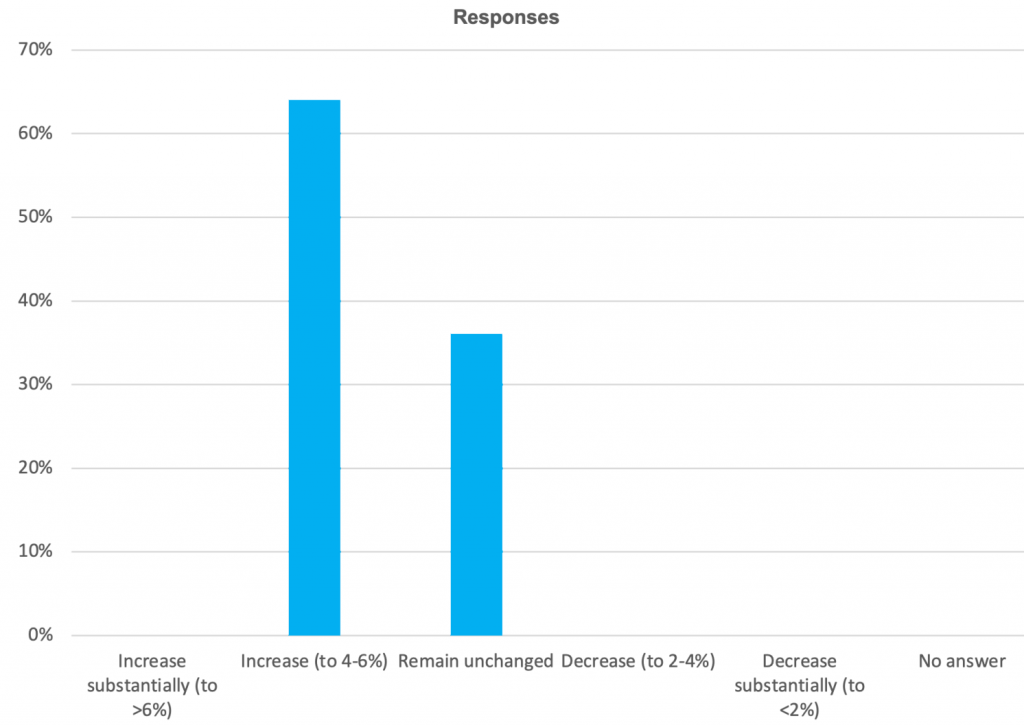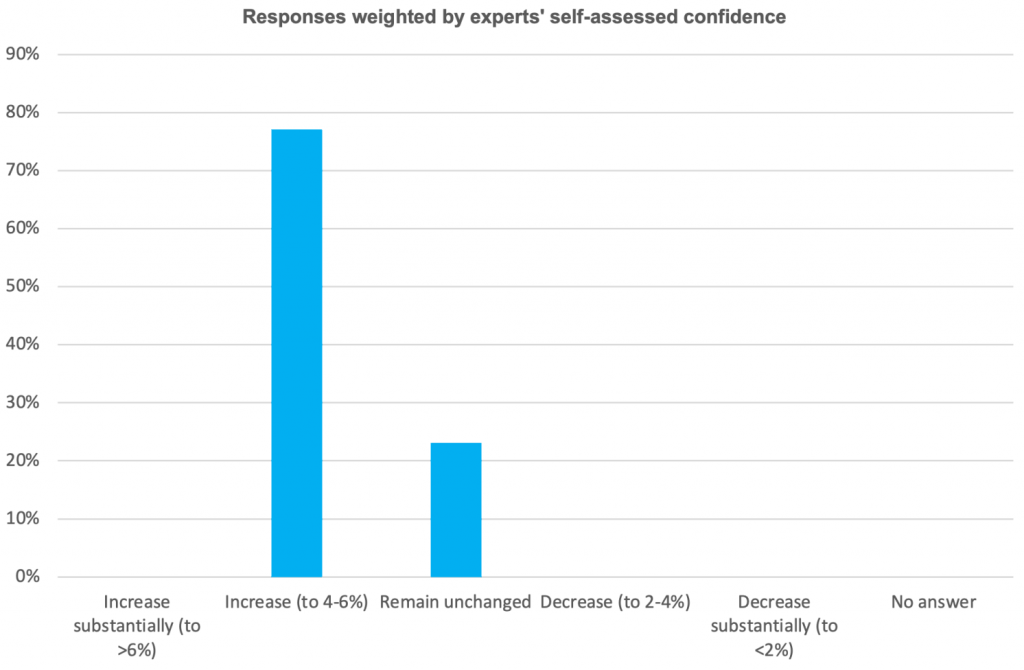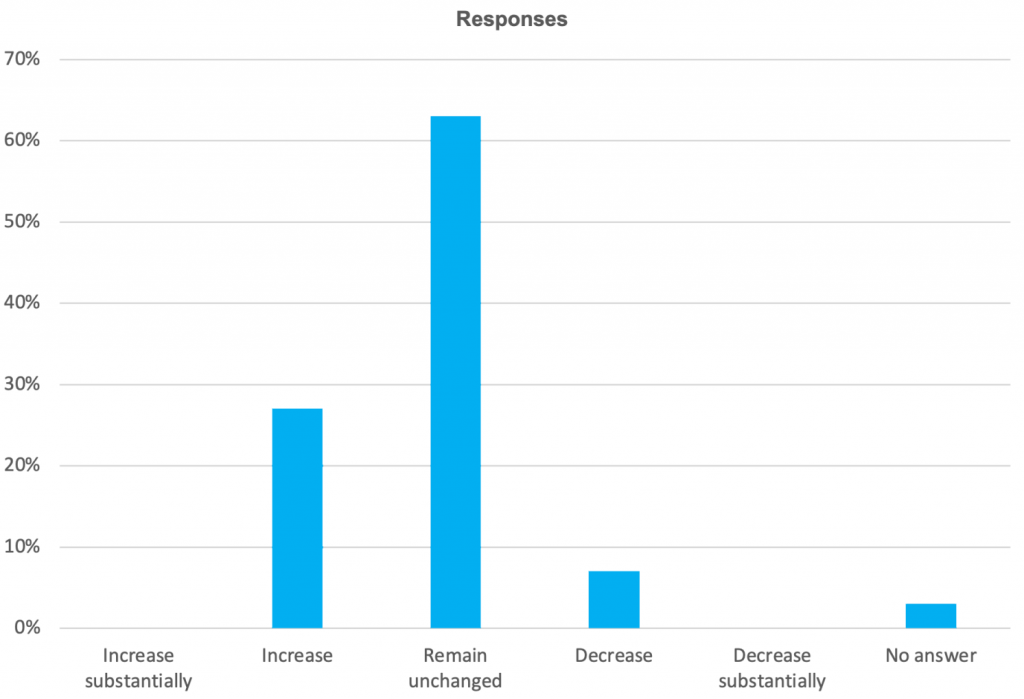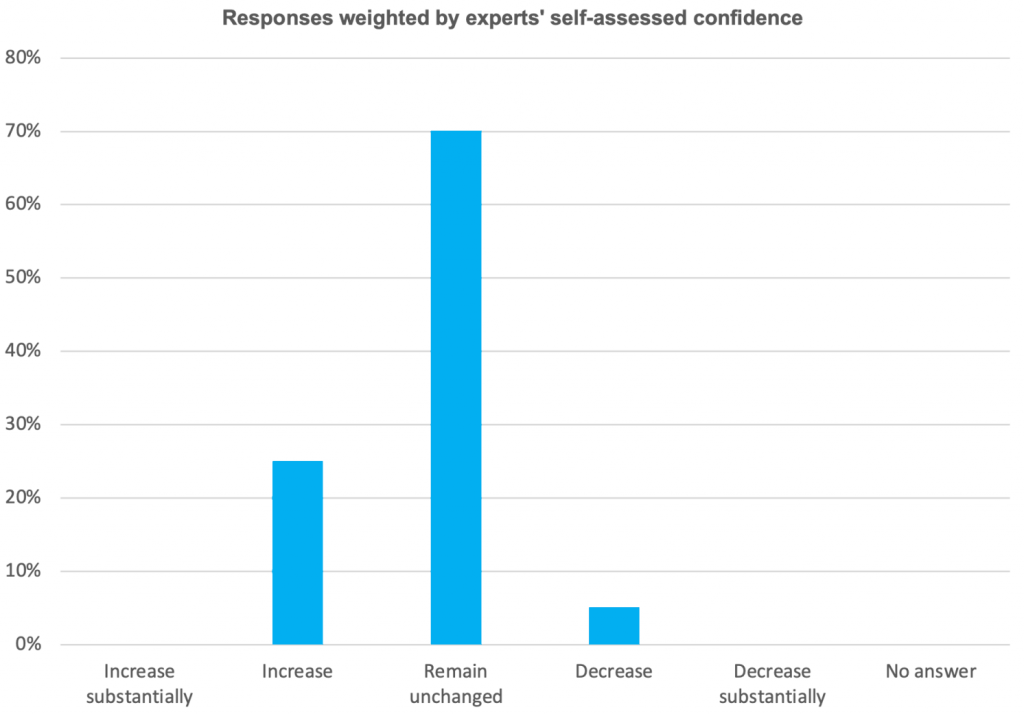_ Ethan Ilzetzki, associate professor of economics (with tenure), London School Of Economics And Political Science; Suryaansh Jain, BSc economics student, London School Of Economics And Political Science. CEPR-VoXEU, 20 June 2023.*
The use of artificial intelligence for day-to-day tasks has increased rapidly over the last decade. The May 2023 CfM-CEPR survey asked the members of its European panel to predict the impact of AI on global economic growth and unemployment rates in high-income countries over the upcoming decade. Most panellists think that AI is likely to boost global growth to 4–6% per annum (relative to an average of 4% over the past few decades). Most of the panel also believes that AI is unlikely to affect employment rates in high-income countries, with the remainder split between predicting an increase and a decrease in unemployment rates. Notably, most panellists indicate a great degree of uncertainty regarding their predictions, because AI is still in its infancy.
***
At the 2023 World Economic Forum, tech entrepreneur Mihir Shukla noted: “People keep saying AI is coming but it is already here”. The use of artificial intelligence (AI) for day-to-day tasks has increased rapidly over the last decade and ChatGPT (developed by OpenAI) is a prime example of this, with the popular generative AI used by more than a billion users for everyday tasks like coding and writing. The speed and scale of AI uptake can be captured by a simple fact: it took ChatGPT just 60 days to reach its 100 millionth user; in contrast, Instagram took two years to reach the same milestone. A recent Stanford University report found that the number of AI patents increased 30-fold between 2015 and 2021 (HAI 2023), highlighting the rapid rate of progress made in the AI development sphere. AI-powered technologies can now perform a range of tasks, including retrieving information, coordinating logistics, providing financial services, translating complex documents, writing business reports, preparing legal briefs, and even diagnosing diseases. Moreover, they are likely to improve the efficiency and accuracy of these tasks due to their ability to learn and improve via the use of machine learning (ML).
AI is generally acknowledged to be an engine of productivity and growth. With its ability to process and analyse enormous volumes of data, it has the potential to boost the efficiency of business operations. The McKinsey Global Institute predicts that around 70% of companies will adopt at least one type of AI technology by 2030, and less than half of large companies may use the full range of AI technologies. Price Waterhouse Coopers predicts that AI could increase global GDP by 14% in 2030 (PwC 2017).
Research into the impact of AI on the labour market has expanded recently. Acemoglu and Restrepo (2018) provide a theoretical framework to understand the impact of new technologies on the labour market. They decompose the effect of new technologies on labour into three broad effects: a displacement effect, a productivity effect and a reinstatement effect (new technologies can serve as a platform to create new tasks in many service industries, where labour has a comparative advantage relative to machines, boosting labour demand).
Frank et al. (2019) classify current literature on the labour market implications of AI into two broad categories: a doomsayer’s perspective and an optimist’s perspective. Doomsayers believe that labour substitution by AI will harm employment. Frey and Osborne (2013) estimate that 47% of total US employment is at risk of losing jobs to automation over the next decade. Their research reveals that a substantial share of employment in service occupations – where most US job growth has occurred over the past decades – are highly susceptible to computerisation. Bowles (2014) uses Frey and Osborne’s (2013) framework to estimate that 54% of EU jobs are at risk of computerisation. Acemoglu and Restrepo (2017) provide a historical example of excessive automation negatively affecting the labour market due to weak productivity and reinstatement effects, finding that areas in the US most exposed to industrial automation in the 1990s and 2000s experienced large and robust negative effects on employment and wages.
AI is also expected to have a disruptive effect on the composition of the labour market. Autor (2015) presented evidence that the labour market has become polarised over the last few decades towards low-skilled and high-skilled jobs and away from medium-skilled jobs, due to the advent of computers. However, he stated that this polarisation is likely to be reversed, as some low-and-medium skilled jobs are likely to be relatively resistant to automation, while some highly-skilled but relatively routine jobs may be automatable (potentially with technologies like AI). However, Petropoulos and Brekelmans (2020) concluded that unlike the computer and robotic revolution, the AI revolution is unlikely to cause job polarisation as it will affect alter low-skilled, middle-skilled and high-skilled jobs.
Optimists believe that AI’s productivity and reinstatement effects will be more than enough to compensate for the substitution effect. Some opinion pieces project that AI and robotics will have created up to 90 million jobs by 2025, indicating a strong positive labour market impact. The World Economic Forum concluded in October 2020 that while AI would likely take away 85 million jobs globally by 2025, it would also generate 97 million new jobs in fields ranging from big data and machine learning to information security and digital marketing.
Lawrence et al. (2017) argue that AI automation is unlikely to negatively impact the employment market due to its large positive spillover effects (reinstatement effect), which would counteract the negative direct effects of substitution in the labour market and can be seen as a Schumpeterian ‘creative destruction’. They believe that automation is likely to transform, rather than eliminate, work. In contrast to other studies finding larger negative effects, Arntz et al. (2016) estimate that only 9% of jobs in the UK are susceptible to automation in the next decade. They argue that instead of substitution, transformation is more likely to occur, with 35% of jobs would change radically in the next two decades.
Nakamura and Zeira (2018) build a task-based theoretical model that shows that automation need not lead to unemployment in the long run. Somers et al. (2022) conduct a systematic review of the empirical literature on technological change and its impact on employment and find that the number of studies that support the labour substitution effect is more than offset by the number of studies that support the labour-creating/reinstating and real income effects of new technologies. Moreover, they find that studies that analyse the net employment effect of technological change suggest the net impact of technology on labour to be rather positive than negative, reaffirming this narrative. Bholat (2020) further notes that job losses in specific sectors due to new technologies have historically been counter-balanced by broad-based gains in aggregate real income as these technologies create higher quality and lower priced goods and services. This leads to higher disposable income which boosts demand for new products, which in turn, boosts labour demand in such sectors. Alan Manning notes that some of the direst predictions about the impact of automation on employment during the past decade have not come to pass (Bholat 2020). This may indicate that concerns about the impact of AI on employment are slightly exaggerated.
The May 2023 CfM-CEPR survey asked the members of its panel to forecast the impact of AI on global economic growth and unemployment rates in high-income countries over the upcoming decade. The survey contained two questions. The first asked the panellists to forecast the impact of AI on global economic growth over the upcoming decade. The second asked them to predict the impact of AI on unemployment in high-income countries in the upcoming decade.
Question 1: What will be the implications of recent developments in AI on global economic growth, as they mature over the upcoming decade?


Twenty-seven panel members responded to this question. The majority of the panel (64%) believes that AI will increase global economic growth to 4–6% per annum over the upcoming decade. The remainder of the panel (36%) thinks that AI will have no significant effect on global growth. Notably, most panellists express a great degree of uncertainty with their predictions because
Almost two-thirds of the panel believes that the development of AI over the upcoming decade will positively impact economic growth. Jorge Miguel Bravo (Nova School of Business and Economics, Lisbon) cites the widespread uptake of machine learning as a ‘general purpose technology’ across the developed and developing world as the main reason why he would “bet on the upside rather than no change or fall”. Ugo Panizza (The Graduate Institute, Geneva (HEID)) echoes these thoughts, claiming that “AI will lead to an increase in productivity and thus higher economic growth”. However, he notes some caveats to this prediction, stating that “AI could increase unemployment and inequality and this may have backlashes on productivity and growth”. Robert Kollmann (Université Libre de Bruxelles) similarly expresses subdued optimism regarding the advent of AI, arguing that it is unlikely to affect the long-term trend growth rate of world GDP, but could boost global growth slightly, by around “0.5”.
Most panellists believe that the implications of AI on global economic growth are extremely uncertain, rendering forecasting impossible. Andrea Ferrero (University of Oxford) summarises this view: “I expect AI to have a significant impact on the economy, but I’m not really sure how. I can imagine that some sectors will benefit more than others, and some may even suffer. The implications for economic growth overall are highly uncertain in my view.” Jagjit Chadha (National Institute of Economic and Social Research) states that the overall impact of AI will depend on several factors – “which policies are adopted, how monopoly power is challenged and what new ideas are ultimately released” – and hence, he cannot say what the impact will be “with any degree of certainty”.
Ricardo Reis (London School of Economics) succinctly summarises the great degree of uncertainty shared by the panel: “Forecasting future growth over a decade is very hard, so ‘not confident’ is the most relevant part of this answer.”
Question 2: What will be the implications of recent developments in AI on unemployment in high-income countries over the upcoming decade?


Twenty-nine panel members responded to this question. Most of the panel (63%) believes that AI will not affect employment rates in high-income countries across the next decade. The majority of the remainder (27%) think that developments in AI could increase unemployment in high-income countries. Only two panellists believe that AI could decrease unemployment in high-income countries over the upcoming decade. Notably, more than half of the panel express a lack of confidence in their responses, indicating the high degree of uncertainty surrounding this question.
Most panellists believe that AI developments are unlikely to impact unemployment in high-income countries over the long run. Michael Wickens (Cardiff Business School and University of York) cites previous technological changes to support this stance: “The number of jobs and the level of unemployment will not change but the number of hours of work will fall and leisure increase. This is what has happened following past tech[nological] improvements. The same thing will happen with AI.” Echoing this view, Cédric Tille (The Graduate Institute, Geneva) states that “unemployment effects may be limited” but notes that “the impact on income inequality and need for redistribution policy may be large”. Maria Demertzis (Bruegel) argues that the impact of unemployment could depend on reskilling, stating “the quicker this [reskilling] happens, the less the impact on unemployment”.
Several panellists indicate uncertainty regarding long-term predictions of the impact of AI on employment. Andrea Ferrero (University of Oxford) highlights this uncertainty: “I expect unemployment to increase in the short run as human employment in some tasks and jobs becomes obsolete. In the medium run, the supply will adjust and it’s possible that AI may even reduce the natural rate of unemployment in the long run. I’m just not sure.”
A fraction of the panel expresses pessimism regarding the impact of AI on the labour market due to its impact on vulnerable groups. Wouter den Haan (London School of Economics) sums up this viewpoint: “My concern is that AI may be bad for the more vulnerable in the labour markets like the ones who will not be that easy to adapt to a new environment”.
However, a few panel members express an opposing view, claiming that may actually decrease unemployment in high-income countries. Volker Wieland (Goethe University Frankfurt and IMFS) suggests that AI could potentially decrease unemployment rates and the number of hours worked.
References
Acemoglu, D and P Restrepo (2017), “Robots and Jobs: Evidence from US Labor Markets”, SSRN Electronic Journal 128(6).
Acemoglu, D and P Restrepo (2018), “Modeling Automation”, SSRN Electronic Journal.
Agrawal, A, J Gans, and A Goldfarb (eds) (2019) The Economics of Artificial Intelligence: An Agenda, University of Chicago Press.
Arntz, M, T Gregory and U Zierahn (2016), “The Risk of Automation for Jobs in OECD Countries”, OECD Social, Employment and Migration Working Paper No. 189.
Autor, D H (2015), “Why Are There Still So Many Jobs? The History and Future of Workplace Automation”, Journal of Economic Perspectives 29(3): 3–30.
Bholat, D (2020), “The impact of machine learning and AI on the UK economy”, VoxEU.org, 2 July.
Bowles, J (2014), “Chart of the Week: 54% of EU jobs at risk of computerisation”, Bruegel blog.
Frank, M R, D Autor, J E Bessen et al. (2019), “Toward understanding the impact of artificial intelligence on labor”, Proceedings of the National Academy of Sciences 116(14): 6531–6539.
Frey, C B and M A Osborne (2013), “The Future of employment: How Susceptible Are Jobs to computerisation?”, Technological Forecasting and Social Change 114(1): 254–280.
HAI – Institute for Human Centered AI (2023), Artificial Intelligence Index Report 2023, Stanford University.
Lawrence, M, C Roberts and L King (2017), “IPPR Commission on Economic Justice Managing Automation Employment, inequality and ethics in the digital age”, IPPR Discussion Paper.
Nakamura, H and J Zeira (2018), “Automation and unemployment: Help is on the way”, VoxEU.org, 11 December.
Petropoulos, G and S Brekelmans (2020), “Artificial intelligence’s great impact on low and middle-skilled jobs”, Bruegel blog.
PwC (2017), The macroeconomic impact of artificial intelligence.
Somers, M, A Theodorakopoulos and K Hötte (2022), “The fear of technology-driven unemployment and its empirical base”, VoxEU.org, 10 June.
* Republished from the original publication on VoxEU in accordance with their copyright rules.

One comment